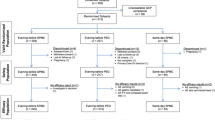Abstract
Introduction
Adequate bowel preparation is necessary for a complete colonoscopy. Polyethylene glycol-electrolyte oral solution (PEG-EOS), sodium picosulphate (SS) and sodium biphosphonate (SP) are the three most commonly used purgative agents. We aimed to determine their efficacy and tolerability compared to each other in a randomised study.
Methods
313 patients were randomly assigned to receive either PEG-EOS, SS or SP. Patients completed a tolerability score pre-colonoscopy. A cleanliness score was used to document adequacy of bowel preparation. A separate group of patients completed taste scores for the three cathartic agents before and after addition of flavour.
Results
PEG-EOS was the worst-tolerated regimen but achieved the highest rates of right colonic cleansing and the lowest rate of incomplete colonoscopies. There were no statistical differences in the rates of rectosigmoid and mid-gut cleansing among the three agents. SS was by far the preferred purgative in the taste assessment study. Addition of flavour increased significantly taste scores for PEG-EOS.
Conclusion
For adequate bowel cleansing PEG-EOS is the most effective but is the least tolerated and least preferred among patients. Addition of flavour increases significantly patients’ acceptance of PEG-EOS.




Similar content being viewed by others
References
Wexner SD et al (2006) A consensus document on bowel preparation before colonoscopy: prepared by a task force from the American Society of Colon and Rectal Surgeons (ASCRS), the American Society for Gastrointestinal Endoscopy (ASGE), and the Society of American Gastrointestinal and Endoscopic Surgeons (SAGES). Gastrointest Endosc 63(7):894–909
Ell C et al (2003) A randomized, blinded, prospective trial to compare the safety and efficacy of three bowel-cleansing solutions for colonoscopy (HSG-01*). Endoscopy 35(4):300–304
Jansen SV et al (2011) Preparation before colonoscopy: a randomized controlled trial comparing different regimes. Eur J Gastroenterol Hepatol 23(10):897–902
Kastenberg D et al (2007) Tolerability and patient acceptance of sodium phosphate tablets compared with 4-L PEG solution in colon cleansing: combined results of 2 identically designed, randomized, controlled, parallel group, multicenter phase 3 trials. J Clin Gastroenterol 41(1):54–61
Renaut AJ et al (2008) A randomized controlled trial comparing the efficacy and acceptability of phospo-soda buffered saline (Fleet) with sodium picosulphate/magnesium citrate (Picoprep) in the preparation of patients for colonoscopy. Colorectal Dis 10(5):503–505
Schmidt LM et al (2004) Picoprep-3 is a superior colonoscopy preparation to Fleet: a randomized, controlled trial comparing the two bowel preparations. Dis Colon Rectum 47(2):238–242
Tjandra JJ, Chan M, Tagkalidis PP (2006) Oral sodium phosphate (Fleet) is a superior colonoscopy preparation to Picopre (sodium picosulfate-based preparation). Dis Colon Rectum 49(5):616–620
Mathus-Vliegen EM, Kemble UM (2006) A prospective randomized blinded comparison of sodium phosphate and polyethylene glycol-electrolyte solution for safe bowel cleansing. Aliment Pharmacol Ther 23(4):543–552
Lai EJ et al (2009) The Boston bowel preparation scale: a valid and reliable instrument for colonoscopy-oriented research. Gastrointest Endosc 69(3 Pt 2):620–625
Rostom A, Jolicoeur E (2004) Validation of a new scale for the assessment of bowel preparation quality. Gastrointest Endosc 59(4):482–486
Gupta M, Holub JL, Eisen G (2010) Do indication and demographics for colonoscopy affect completion? A large national database evaluation. Eur J Gastroenterol Hepatol 22(5):620–627
Froehlich F et al (2005) Impact of colonic cleansing on quality and diagnostic yield of colonoscopy: the European panel of appropriateness of gastrointestinal endoscopy European multicenter study. Gastrointest Endosc 61(3):378–384
Brahmania M et al (2012) Incomplete colonoscopy: maximizing completion rates of gastroenterologists. Can J Gastroenterol 26(9):589–592
Aljarallah B, Alshammari B (2011) Colonoscopy completion rates and reasons for incompletion. Int J Health Sci (Qassim) 5(2):102–107
El Sayed AM et al (2003) A randomized single-blind trial of whole versus split-dose polyethylene glycol-electrolyte solution for colonoscopy preparation. Gastrointest Endosc 58(1):36–40
Marmo R et al (2010) Effective bowel cleansing before colonoscopy: a randomized study of split-dosage versus non-split dosage regimens of high-volume versus low-volume polyethylene glycol solutions. Gastrointest Endosc 72(2):313–320
Ell C et al (2008) Randomized trial of low-volume PEG solution versus standard PEG + electrolytes for bowel cleansing before colonoscopy. Am J Gastroenterol 103(4):883–893
Author information
Authors and Affiliations
Corresponding author
Rights and permissions
About this article
Cite this article
Heetun, Z., Crowley, R., Zeb, F. et al. Comparison of polyethylene glycol vs sodium picosulphate vs sodium biphosphonate by efficacy in bowel cleansing and patients’ tolerability: a randomised trial. Ir J Med Sci 185, 629–633 (2016). https://doi.org/10.1007/s11845-015-1320-7
Received:
Accepted:
Published:
Issue Date:
DOI: https://doi.org/10.1007/s11845-015-1320-7




